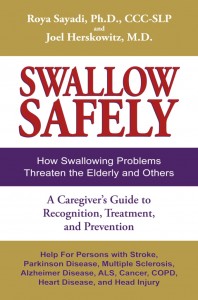 Toward the end of my father’s life, he had difficulty chewing food and eventually swallowing. I didn’t know it then. One morning, while feeding him breakfast at the nursing home, I stuffed more and more food in his mouth, thinking this might stimulate him to swallow.
Toward the end of my father’s life, he had difficulty chewing food and eventually swallowing. I didn’t know it then. One morning, while feeding him breakfast at the nursing home, I stuffed more and more food in his mouth, thinking this might stimulate him to swallow.
Upon seeing his stuffed cheeks, the aide who usually helped him eat exclaimed, “Brenda what are you doing?”
Embarrassed I confessed, “He won’t eat!”
What did I know?
I’m embarrassed to admit it now, thanks to Roya Sayadi, PhD, CCC-SLP and Joel Herskowitz’s, MD new book. Swallow Safely educates and empowers caregivers to prevent those with swallowing problems from choking.
[TCV Update 2/1/2022 Sayadi and Herskowitz’s website URL is broken. URL is now to their book on Amazon.com]
Highlights:
Four-steps to the swallowing process, p. 15.
It’s amazing how many of us don’t even focus on our eating; yet, with an estimated 600 swallows daily, a lot can go wrong!Difference between a “café coronary” and a heart attack, p. 49.
Heimlich maneuver—on someone else and self-administered, p. 58.
Two additional points bear mentioning:
follow then stay with a choking person, as embarrassment may cause him/her to leave the setting.
pneumonia may not show up for months after a choking incident.Medications and how to manage them when they cause dryness and swallowing complications, p. 78 and in appendix. Tips for taking meds, p. 85.
Treating swallowing problems including: warnings about mixing foods, the need for sensory stimulation and aiding the swallow reflex with an ice-cold applicator dipped in lemon juice, diet modification can get emotional, aspirating even while tube feeding, pgs. 91- 107.
What to expect when going for a thorough swallowing exam, p. 113.
The role of the caregiver, p. 121 I was particularly touched by this paragraph (italics added for emphasis): It is your love that guides you to learn more, your caring that ensures… recommendations are carried out…, your patience and strength that enable you to be with someone you love through difficult times.
Mindful swallowing, p.125.
Read this twice, it can save your or your loved one’s life!Appendices include a form where you can record your observations of a loved one’s difficulty swallowing and tips for swallowing safely.
Sayadi and Herskowitz caution family caregivers to be more specific in helping loved ones define their advance directives. Many are either DNR (Do Not Resuscitate) or resuscitate. Yet, there remains a lot of gray area in between these extremes, such as when a mildly impaired individual chokes on a bone. In such an instance, detailed instructions on the Heimlich maneuver are offered.
Given the number of medical terms used throughout the book, it would have been nice to refer to a glossary–something the authors should consider including in a subsequent edition.
Also, as one whose nose runs each time I eat, I’d like to learn more about this and why it occurs. When I asked Herskowitz, he offered the following explanation: The runny nose and the watery eyes result from reflex irritation of the mouth, throat, or (most ominously) the larynx.
I know I could have been much better informed had Swallow Safely been available while my father was still alive.
Recommended for family and professional caregivers for those experiencing swallowing difficulties due to stroke, Alzheimer’s, MS, ALS, cancer, heart disease, and even healthy individuals who experience swallowing problems.
For more information, also visit: How can I tell if my loved one has a swallowing problem?
Reviewed by Brenda Avadian, MA on July 27, 2010
Editor, The Caregiver’s Voice Book Review








